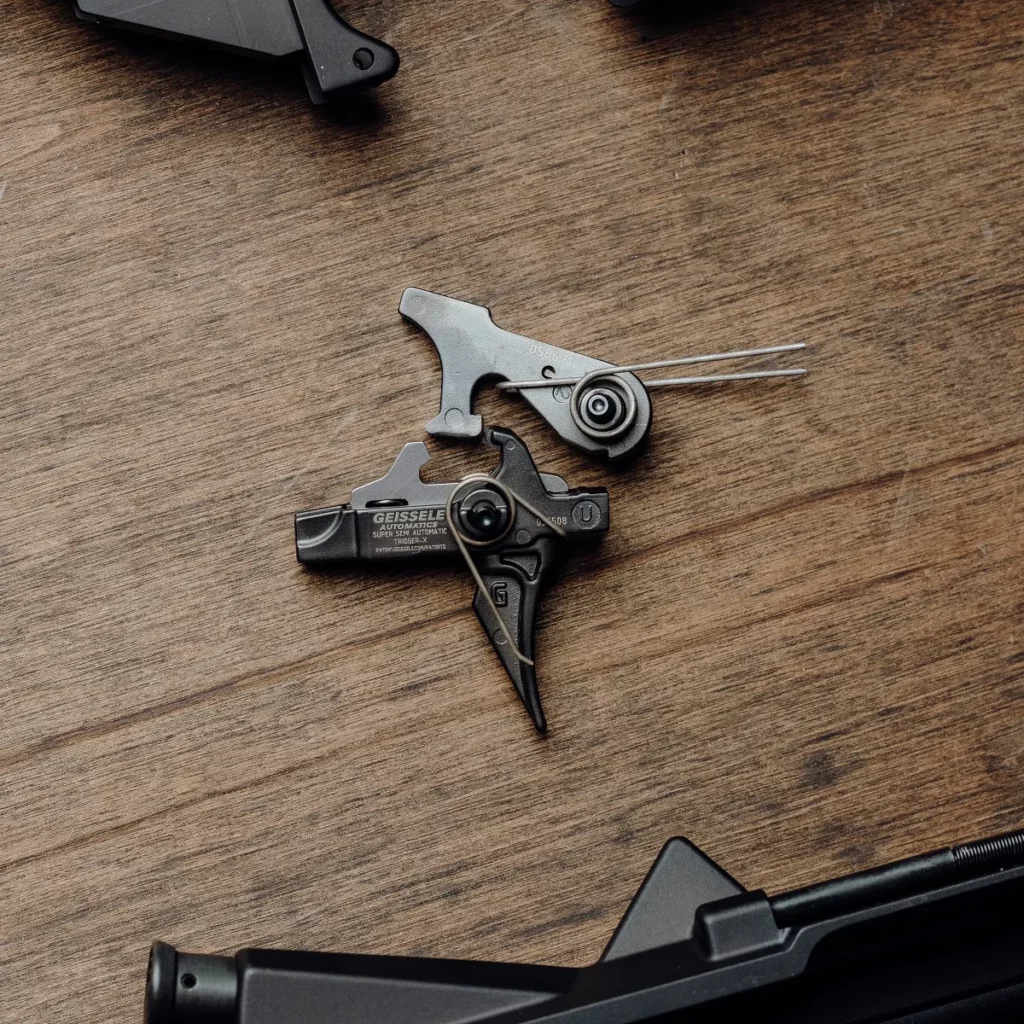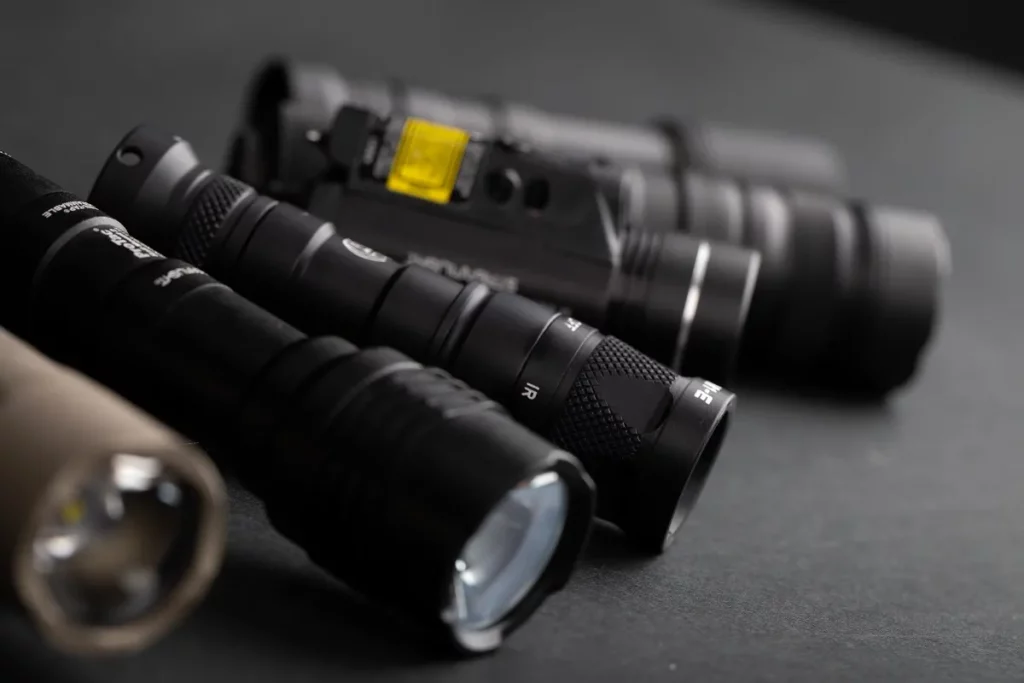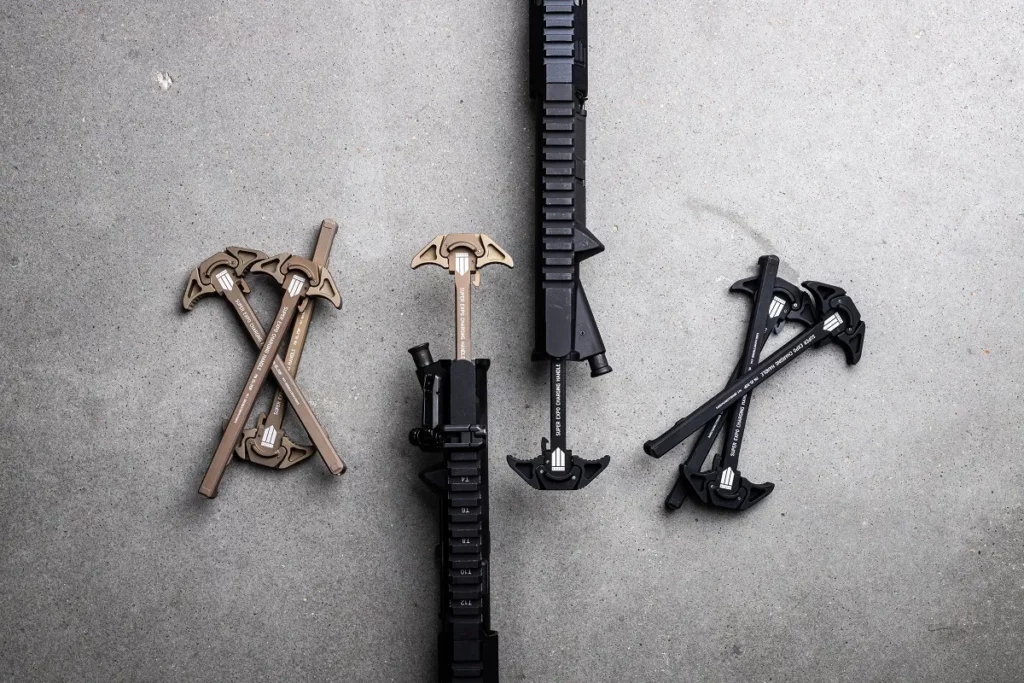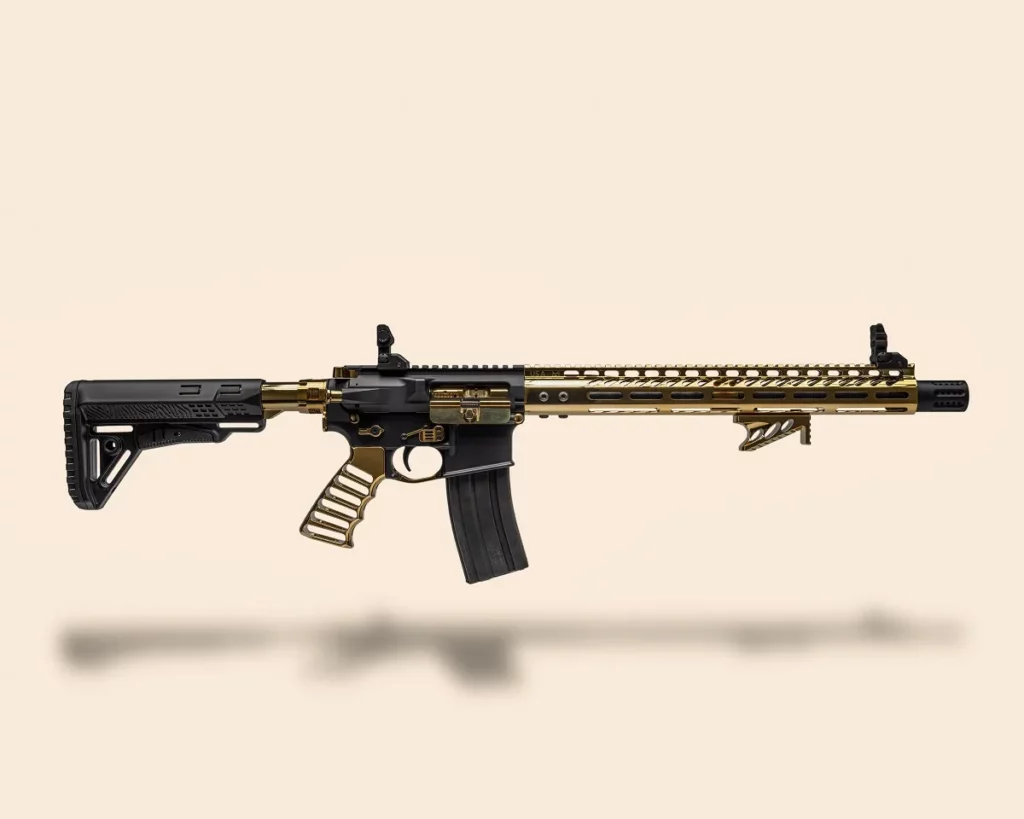Unboxing your first AR-15 can be like staring at a blank canvas. You know you want to put something on it—it’s practically demanding it—but how do you know where to start?
There are thousands of AR-15 upgrades and accessories out there to choose from. Some of them, like IR units for use with night vision devices, are made for a specific purpose; others are very broadly applicable, like triggers. Looking at the plethora of options, it can be hard to tell what to get first.
On a rifle straight out of the box, the sights are often simple, the trigger no better than Mil-Spec, and the controls may be basic. If your new rifle includes standard furniture like an A2 grip and waffle stock, you may also want to upgrade those. Few of us have the budget to upgrade everything at once, so some upgrades must be prioritized over others.
Below, we’ve put together a list of common upgrades in order of the magnitude of their effect on your rifle’s capability and shooting experience. We’ll walk you through how they improve your rifle, why you might need them, and what to look for when shopping for one.
AR-15 Optics
There’s no other accessory that is going to change the capability of your firearm as radically as an optic. Iron sights are fine, but that’s really all that can be said for them. They’re rugged and reliable and get the job done, but optics can surpass them in almost every way.
The exact type and model of optic you need will vary depending on your intended use for your firearm, but all of them offer a measurable improvement over irons. Red dots are faster and more forgiving of imperfect head placement, as well as easier to use in darkness. The magnification offered by scopes allows them to hit targets that iron sights simply can’t. The only area where iron sights truly excel is weight, and even then, it’s not by much.
For applications that require speed and short-range performance above all else, a red dot is the obvious choice. This can include home- or self-defense as well as certain competitions and target shooting at short to intermediate ranges. Red dots simplify the aiming process by removing the step of aligning the front and rear sights and instead allow users to simply center the dot on the target and fire. This results in a significant boost in target acquisition speed.
Moreover, red dots—and most other optics, for that matter—allow for a target-focused aiming approach. Instead of being focused on a front sight, proper use of most optics and all red dots means being focused on the target, then aligning the dot or crosshair. This is invaluable for defensive use, as the stress and adrenaline caused by a threat to your safety will typically cause you to focus on the threat whether you intend to or not.
Scopes similarly offer a target-focused aiming solution, but their limited eye box and parallax make them slower than red dots in true short-range work. Instead, they offer magnification, more sophisticated reticles, and more precise aiming points.
Shop All In-Stock Red Dot Sights
The magnification is perhaps the largest factor; even the best marksmen in the world benefit from magnification, and for amateur and intermediate users, the effects are often even more dramatic. A magnified optic allows you to hit targets that would be difficult or impossible to engage with a red dot or iron sights.
Additionally, the sophisticated reticles available in scopes allow for many capabilities that unmagnified optics typically can’t offer. Many scopes now offer reticles that help you determine the range to an unknown target or hold for bullet drop, wind drift, or target movement.
Scopes also feature more precise adjustment and aiming points than most unmagnified optics. The average red dot will usually adjust in 1/2 MOA increments, while scopes are commonly half that or less. Scopes generally use finer aiming points as well, whether traditional crosshairs, floating dots, or other designs. This all translates into the ability to put a bullet more precisely where you want it. As the saying goes, “Aim small, miss small.”
Halfway between red dots and rifle scopes are prism scopes, which offer modest fixed magnification with a compact footprint. Prism scopes, especially those with low magnification, are much more nimble than full-size rifle scopes but still come with many of the same advantages, such as an etched reticle and compatibility with astigmatism.
CQB-oriented 1x prism scopes are often used in the same role as red dots, while 3x and higher prism scopes serve as great general-purpose optics for rifles, especially where weight is a priority.
Luckily, we live in a golden age of optics right now. Advanced optics are more accessible than ever, with even intermediate optics capable of performing in the most demanding tasks.
Unfortunately, that makes it almost impossible for us to tell you what exactly to buy. Between the sheer number of quality optics available and the large disparity in use cases, there’s simply too much information to fit here. Still, in today’s market, it’s hard to go wrong so long as you buy from a reputable brand with a reliable warranty.
Shop All In-Stock Rifle Scopes
That said, if this is your first and only AR-15, a quality red dot like Holosun’s HS503 series is always a good starting point. You may also want to consider something like our SLx® 1x MicroPrism, which combines a red dot’s close-quarters performance with a prism scope’s reliability. Since the MicroPrism has an etched reticle and an adjustable diopter, it’s fully functional even with severe astigmatism, which can significantly affect the appearance of standard red dots.
If you’d like more information on the pros and cons of red dots and scopes for your rifle, you can check out our thorough comparison here.
AR-15 Triggers
Maybe your gun doesn’t need a weapon light. Maybe you’ve already got one. Either way, the next accessory on our list is a new trigger.
Your average AR-15 will generally come with some version of a Mil-Spec fire control group. These are usually serviceable but far from ideal. Mil-Spec triggers generally require around 5.5-8.5 lbs of force to actuate and can often be gritty or have multiple unintended “stages” caused by imperfections in the surface of the connection points.

The trigger is one of the primary interfaces between the user and the rifle. While they don’t affect mechanical accuracy, they can greatly affect the user’s practical accuracy. As such, a high-quality trigger is often one of the fastest ways to shrink both your groups and split times with one upgrade.
Modern match-grade triggers like those available from Geissele, Timney, Rise Armament, and countless others offer reduced pull weight, shorter pull distances, and smooth travel. The result is a trigger that pulls faster, easier, and with less interference to the firearm, making for better groups and faster shots.
It’s up to each individual user how light they are willing to go. Some users prefer a Mil-Spec weight for safety, but an aftermarket trigger can offer a smoother and more consistent pull. Triggers such as SOLGW’s Liberty Fighting Trigger or BCM’s PNT offer a full Mil-Spec pull weight but can still dramatically improve your experience.
On the other hand, match-grade triggers with weights as low as 2 lbs are available in single-stage or two-stage varieties for every application. Users who do action-oriented sports like 3-Gun often prefer single-stage models for their simplicity and speed, while long-range shooters generally opt for two-stage models to stage the trigger for a perfect shot.
Geissele’s SSA and SSA-E triggers are among some of the most popular two-stage models on the market. Both offer butter-smooth travel and a clean, crisp break. In fact, the only difference between the two is the pull weight, with the SSA-E being about a pound lighter than the SSA.
For competitors, Geissele’s single-stage SD3G is purpose-built for 3-gun and similar dynamic sports. It features a flat trigger bow to maximize the user’s mechanical advantage and lower the perceived pull weight and what Geissele describes as a Hybrid Rolling Break for fast, smooth shots. It even comes with two sets of springs, so users can choose how light or heavy they’d like their trigger to be.
AR-15 Weapon Lights
After optics, weapon lights are probably the most game-changing accessory you can add to your AR-15. While it’s true that not every firearm needs a weapon light, for any firearm that even might be used defensively, your light is a significant lifeline. The ability to see your surroundings and identify a potential threat matters much more than grip ergonomics or trigger smoothness.
For an indoor light, such as one intended for a home defense gun, brightness isn’t nearly as important as it’s made out to be. While many modern lights can crank out 1500 lumens or more, you don’t need that level of brightness to light up a living room. Most lights producing 800 lumens or more will be plenty sufficient to illuminate indoor spaces.

How the light is dispersed matters more than raw output for a home defense light. Lights with a lot of throw—that is, devices that project their light in a tight beam that reaches longer distances—are usually better suited to outdoor use. For an indoor light, you’ll generally want to prioritize flood, which refers to a flashlight’s tendency to spread light over a wide area.
Shop All In-Stock Weapon Lights
Throw and flood exist on opposite ends of a spectrum, so consider your use case before choosing a light. If you want to be able to see out into a large yard or field, a light with strong throw may be preferable. However, you will need some training to use it indoors effectively without blinding yourself.
Brands like Streamlight, SureFire, Modlite, and Cloud Defensive all produce quality weapon lights to fit a range of applications and budgets. If you’d like more guidance on choosing the best weapon light for your rifle, you can check out our in-depth guide here.
AR-15 Enhanced Controls
At this point, we begin to move away from accessories that are going to have an immediate and noticeable effect on your performance into ones that have more subtle benefits. Enhanced controls like short throw safeties and extended magazine releases won’t immediately shrink your groups the way a match trigger or new optic can. Still, they can help shave crucial seconds off of essential functions with your rifle.
Seconds may not sound like much, but they do add up. In a competition, shaving a half-second off of each of your reloads by reducing the time it takes to actuate your safety, drop your mag, and hit your bolt release can add up to double digits by the end of the day. In a defensive situation, seconds can be even more crucial, and anything that puts the odds in your favor is worth consideration.

Enhanced controls can offer other benefits as well, such as ambidexterity. While ambidexterity is sometimes mistaken as a feature primarily benefiting left-handed users, it can be a big improvement for anyone who trains to shoot from their non-dominant side.
The main controls worth replacing are the safety, bolt catch, magazine release, and charging handle. For the safety, an ambidextrous short-throw model like the Radian Talon or FCD ASF offers significant benefits, letting users actuate the safety with either hand and without breaking their shooting grip.
Shop All In-Stock AR-15 Safety Selectors
Improved bolt catches are mostly about increasing the surface area on the paddle to provide more reliable function. By making the bolt catch into a larger target to hit after inserting a fresh mag, you reduce the chance of missing or hitting it with insufficient strength to fully release the bolt carrier group. Some models, like Geissele’s ever-popular Maritime Bolt Catch, also integrate a smaller paddle at the bottom of the catch to make it easier to manually lock your bolt back.
Magazine Catches are offered in extended and ambidextrous models. The benefit of an ambidextrous catch is largely self-evident; as with safeties, ambidextrous mag catches make operating the rifle from your non-dominant shoulder much easier. Extended models can be beneficial for users who have difficulty reaching the standard magazine catch due to their grip or finger length, but some users find them unnecessary.
Charging handles all essentially do the same task, but improved models can offer ambidexterity and other benefits. Unlike Mil-Spec charging handles, ambidextrous ones like Radian’s Raptor series or Geissele’s Super Charging Handle are designed to accommodate both traditional charging methods and “blading,” which is a charging technique that uses the palm of the hand rather than fingers and is slightly faster.
Shop All In-Stock AR-15 Charging Handles
This method of charging can put stress on Mil-Spec charging handles, potentially leading to an eventual failure. Most modern ambidextrous models do not suffer from that limitation.
Charging handles are also available to minimize the amount of gas ejected into the user’s face, which can be an issue for those shooting suppressed.

Aesthetics and Ergonomics
When it comes right down to it, not every accessory is bought purely for performance. Some parts, like upgraded stocks and grips, change the ergonomics of your rifle but don’t necessarily translate into smaller groups or measurably faster drill times. Instead, they just make the rifle feel a little better in the hand.
Similarly, many users may choose one accessory over another simply because of its aesthetic value. You may want to match a color scheme or replicate a neat-looking rifle you’ve seen elsewhere. We won’t say that style makes a better marksman, but range days are always more fun when you love the look of your own rifle. For many, that personalization is one of the most fun parts of outfitting a new AR-15.
Just be mindful of the balance between function and form. At the end of the day, rifles are tools, and you always want the best tool for the job. For example, if you’re building a close-quarters carbine, set aside the precision rifle stock and bipods. Even if they look cool, they probably won’t get you the results you’re looking for on the range.
If you want to go bold on the look of your rifle, the best place to do so is on parts that have little to no impact on your rifle’s performance. Rail covers are a perfect example; you can choose any pattern or color you want. They weigh next to nothing, and they all mostly work the same.
Wrap Up
One of the biggest advantages of the AR-15 platform is the nearly-limitless level of customization available. If there’s ever a part of your rifle you don’t like, you can easily change it.
Of course, the accessories listed here aren’t the only upgrades you can make to your rifle; there’s a whole smorgasbord of barrels, muzzle devices, bolt carrier groups, buffer assemblies, stocks, grips, and more out there, each with its own purpose.
For the biggest impact on your capability with your rifle, a quality optic should be your first step. After that, an improved trigger offers the greatest potential for increased speed and accuracy, followed by enhanced safeties, bolt catches, charging handles, and magazine releases.



